Brief Overview
The term “EAPG” (Early American Pattern Glass) is applied to pressed glass tableware (occasionally including some blown glassware), made in sets, made within the United States primarily in the period 1850-1915, and featuring some type of recognizable pattern (motif, theme or design raised in the glass) which is repeated, often with some slight variations, from piece to piece.
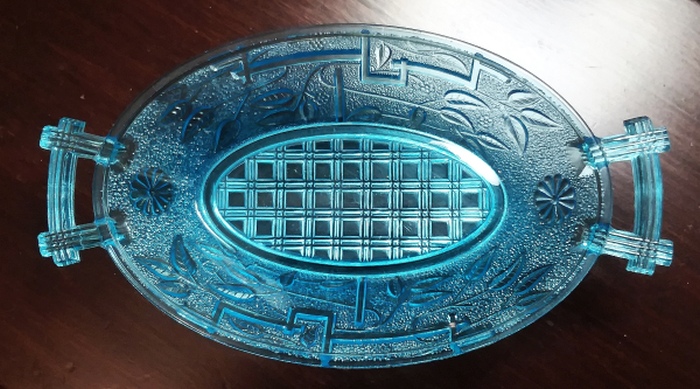
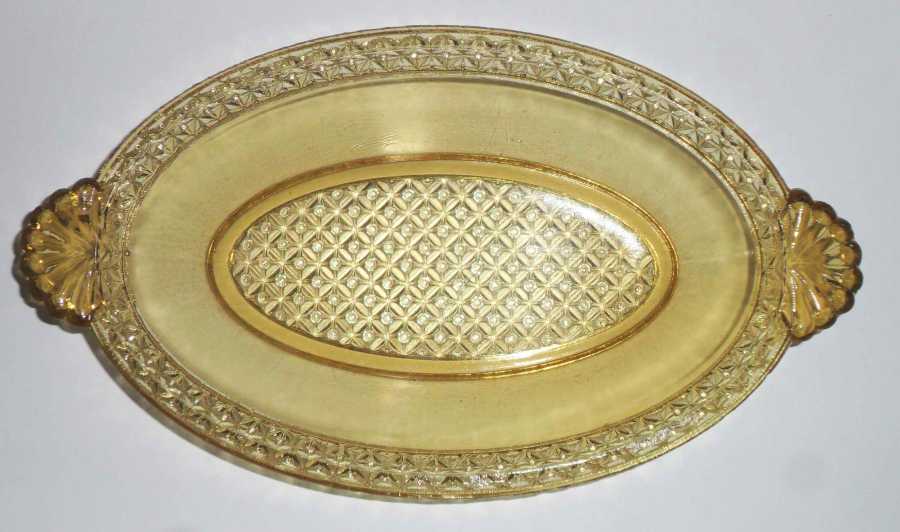
Some EAPG “sets” consisted of only a very few pieces, such as the “basic four” or “table set”: sugar bowl, creamer, spooner (spoonholder) and butter dish. However, many patterns, including some of the most widely collected and better-known patterns, were made in many dozens of forms (shapes or pieces), for example: relish or pickle dishes/bowls, goblets (stemmed wine or water glasses), tumblers, candy dishes, compotes, comports, celery vases, salts (salt dishes or salt cellars), finger bowls, match holders, toothpicks (toothpick holders), sauce dishes, punch cups, punch bowls, mustard jars, syrup pitchers (molasses cans), cheese dishes, vinegar and oil cruets, egg cups, cake plates, bread plates, pickle jars, mugs, large water pitchers, oil lamps, dresser trays, ring trays, jam jars, and others.
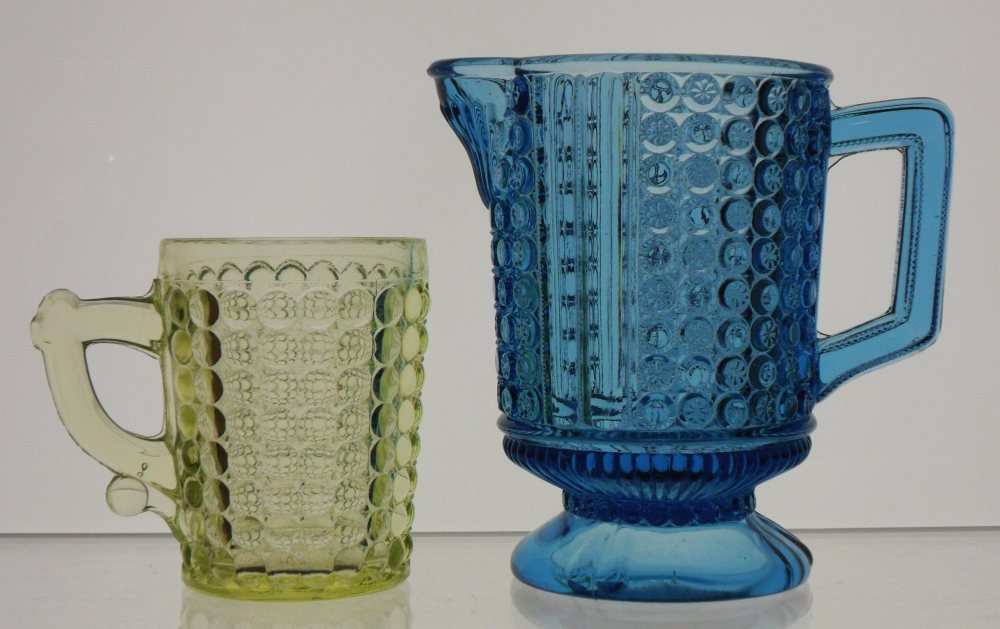
Some glass pieces that are classed together with “EAPG” were made in only one form, such as certain ornamental toothpick holders, match safes, mugs, and other “whimseys” and “novelty ware”.
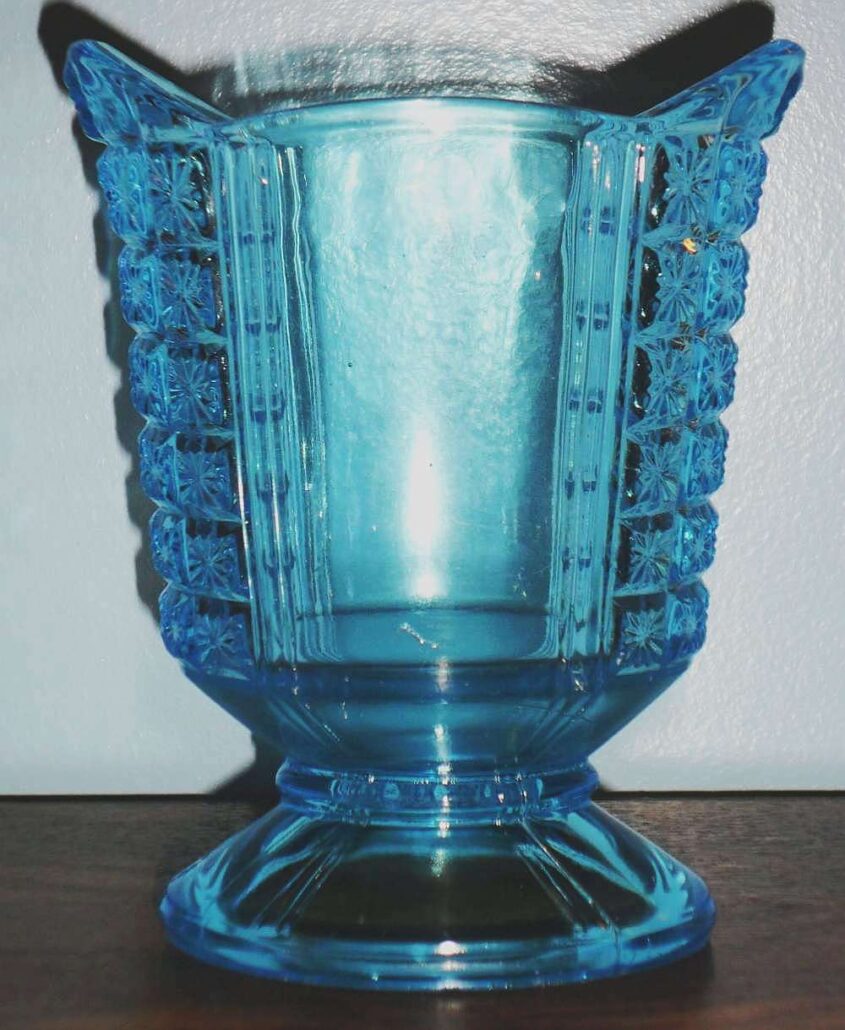
Most of this type of tableware was (originally) relatively inexpensive, and was commonly purchased and used primarily by American “middle class” households.
The heyday of “Early American Pattern Glass” (sometimes called “Early American Pressed Glass”), would be the 1875-1900 period, although a very few patterns were introduced as early as the 1830s and 1840s.
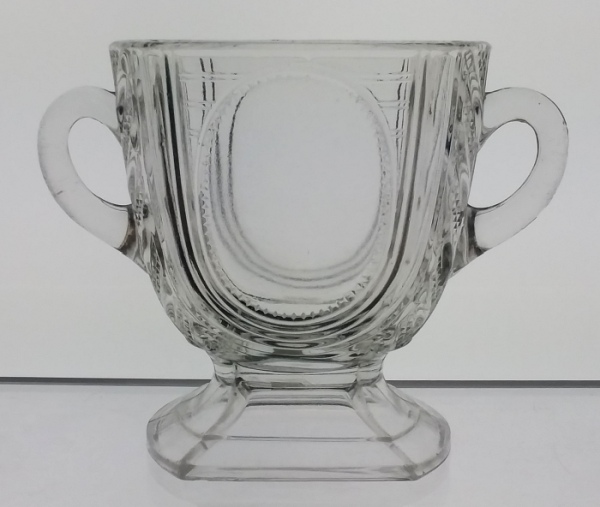
EAPG began to fall out of favor in the 1910s. In the late 1920s, a “new” type of pattern glass, now collectively termed “Depression Glass” came into wide favor with the buying public.
The majority of EAPG is found in clear glass, but many other colors are found. During the height of popularity of colored EAPG ( the mid-1880s), many pieces were made in blue, amber, yellow (“canary” or “vaseline glass”), and some in a light to medium “apple green”, as well as in clear. The color shades can vary somewhat in hue or intensity from one manufacturer to another.
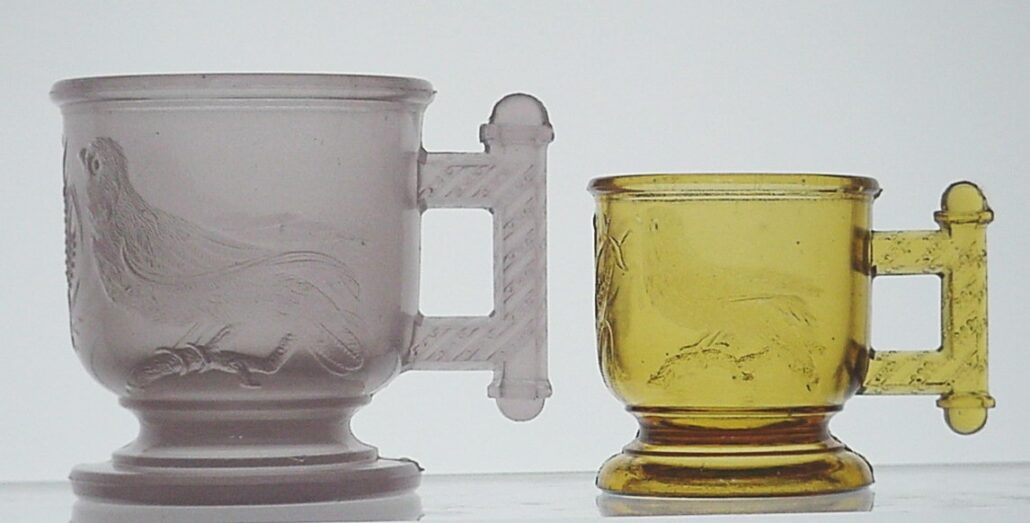
ADVERTISEMENT
ALTERED GLASS
An increasing amount of EAPG (along with bottles, insulators, fruit jars and other types of collectible antique glass) has been artificially altered by irradiation in recent years, turning the clear glass to some shade of medium to very dark purple. (A very tiny percentage of EAPG patterns may have been made originally in some shade of amethyst glass, but most of the glass now commonly encountered in this color has been altered). Artificially color-altered glass is considered “damaged” by most serious collectors or students of EAPG who are especially interested in the provenance, history and original as-made colors found in EAPG. Please check out this page with more information on altered glass: Artifically Purpled Glass.
It is estimated that anywhere from 2,000 to 5,000 individually discernible EAPG patterns may exist, although many of them are only known by one or two pieces, and a lot of the lesser-known patterns do not have names that are universally agreed upon by collectors. EAPG was made by hundreds of glass manufacturers in the US. Many of them were located in the Pittsburgh, PA area, which had the reputation of being the “glass center” of the US during the 1870s and 1880s.
Very large quantities of this pressed glass were churned out during it’s heyday, although a large percentage of it is now no longer available, due to the ravages of time, including typical breakage and sometimes intentional discarding during the many years since its production.
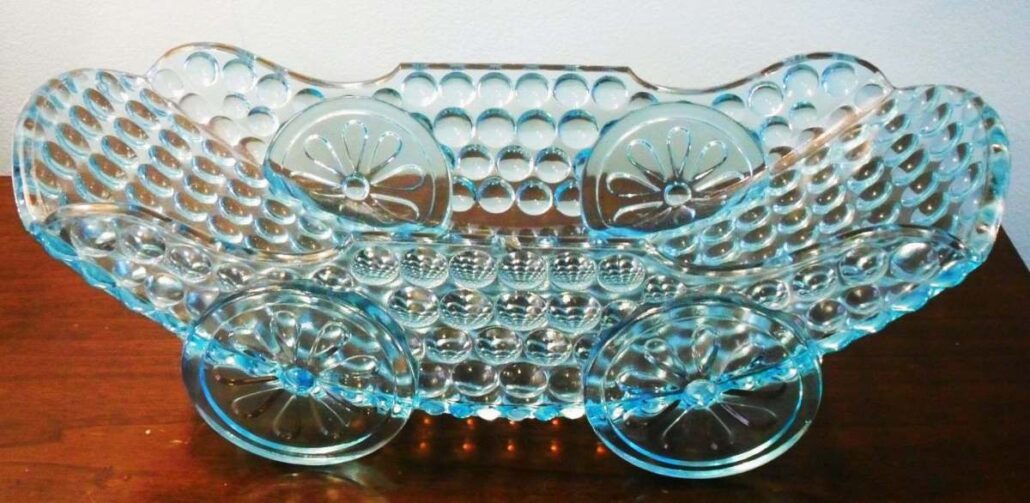
Some of the more commonly seen or well-known patterns would be Daisy & Button, Two Panel, Three Panel, Argus (Thumbprint), Honeycomb, Medallion, Cupid & Venus, Rose in Snow, Sawtooth, Cane, Queen, Wildflower, King’s Crown, Panelled Forget-Me-Not, Thousand Eye (Sensation), Hobnail, Willow Oak, and many, many others. Of these patterns, Daisy & Button is probably the best known (or most easily recognized) pattern dating from the EAPG era, but it, like many others, has been heavily reproduced for many years.
The great majority of Early American Pattern Glass ware was not permanently marked to identify the glass company that made it. However, over the years many older catalogs and other reference literature have helped to identify the glass company that made some of the most popular and well known glass patterns. A number of detailed books are available with information on patterns made by some of these companies. New information is continually being uncovered, up to the present day. A good source of information on EAPG is the Facebook discussion group connected with the EAPGS (Early American Pattern Glass Society). Here is the URL that points to that group: https://www.facebook.com/groups/146031692077139
OTHER RESOURCES ON EAPG
A great website with tons of good in-depth information on EAPG is Elaine Henderson’s site at this URL: https://www.patternglass.com/
Here is a very good article about Early American Pattern Glass with great background information. It is actually a question and answer interview with Elaine Henderson, published online by Collector’s Weekly: EAPG: Collectors Weekly Article
Another website with great information, and HUGE numbers of beautiful photos, is by Pattern Glass editor DoRi Miles. [Edit 4/14/2024]: The original website was unreachable when I tried to access it today, but here is an archived version on the “Wayback Machine” internet archive: EAPGpatterns.com site from DoRi Miles
The EARLY AMERICAN PATTERN GLASS SOCIETY website is here, with LOTS of superb, searchable information on EAPG patterns, shapes, motifs, etc. The photo database there contains THOUSANDS of good quality photographs of EAPG pieces for viewing on computer, tablet or smartphone.
I would strongly suggest anyone interested in learning more about EAPG to browse this site!! The very latest and best summary information on hundreds of glass companies and the pattern glass they produced is contained on this site!
https://www.eapgs.net/index.php
Please click here to go to my site Home Page.
Click here to see the alphabetical list of marks found on bottles, fruit jars, insulators and tableware, starting here: Glass Bottle Marks, Page One
Check out my article on ATTERBURY & COMPANY , a prolific glass manufacturer of the EAPG era.
Here’s my web page with basic information about Depression Glass .
…… And my summary about Carnival Glass.
Please click here to check out one of my newest pages, a general overview on Collectible Milk Glass.
ADVERTISEMENT

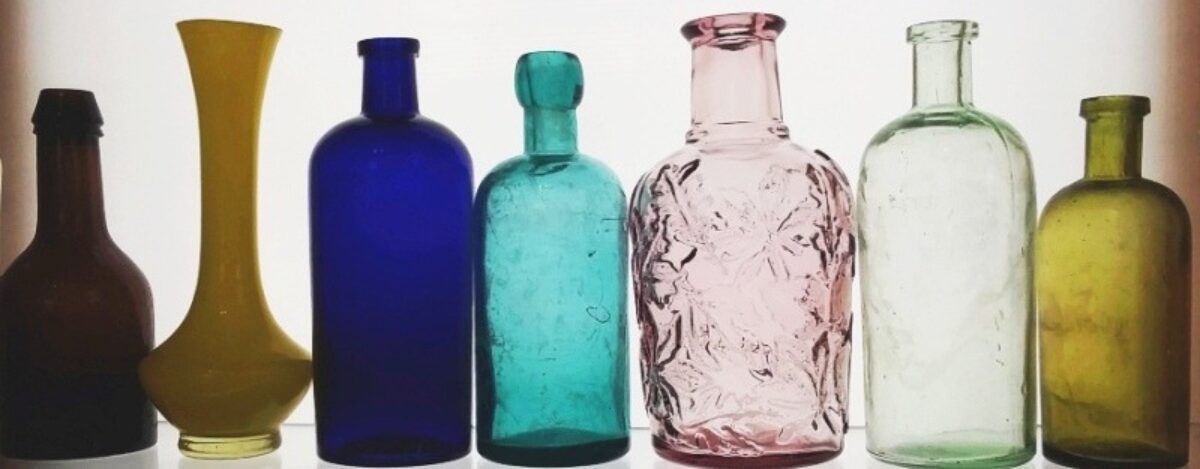
Hello,
I have six turquoise small plates with gorgeous cutouts all around the edge of the plates as well as a glass beading design which completely circles the entire dish.
The marking on the bottom of the plate is M P inside of a triangle. Do you know who this glass maker is?
Thank you for your time! Greatly appreciated.
Best regards,
Yale Butler
Yale, I am not familiar with the mark. I have emailed you directly, as I would like to see a pic of the plates and the mark. It may be a more recent item, and/or may have been made outside the US.
David
1915 is the date used by most EAPG historians The highly-respected Welkers in “Pressed Glass in America”: used 1925 as the end date, but 1915-1925 was a decade in which ads showed left-over stock, not newly manufactured lines. One problem with dating is when dates are established from trade-catalog ads rather than factory sources and it’s especially difficult when the writer doesn’t give the source.. A group of us told eBay in a phone conference years ago a number of things they’ve ignored, one of them was the end date, they still use 1910 which is too early. DoRi Miles, Patter Glass Editor EAPGPatterns.com
Hello DoRi,
Thanks a lot for your information! Although I used the phrase “most heavily” in the text (implying there was not an abrupt end to EAPG production in any specific year, but gradually decreasing popularity), I have changed the date “1910” to “1915” in the paragraph at the top of this page. I also included a link to your site at the bottom of the page. Take care, and thanks again!
David
Hi, David ~ Some Editor I am, leaving the “n” off Patter Glass Editor! Your Thousand Eye carriage is Adams & Co., 1885. I do paid identification on EAPG and also do appraisals. I was asked by Chilton/Wallace-Homestead to write a price guide in the 1980s and still sell it with the option of updating the information, so much has been discovered since then. I also vet eBay listings, website shops,and brick-and-mortar shops for corrections, and additions, clients sent photos from shows, flea markets, yard sales for fast i.d.s, to get an idea as to whether they should buy an item. I have a compote I’m puzzling over, it’s unusual for pattern glass to have an embossed number under the base, this is 65. It might not even be American. One of the things that’s kept me hooked for 58 years is there’s always something I haven’t seen and the learning process is fun. DoRi
Helo DoRi,
I’ve also noticed that most pattern glass doesn’t bear mold numbers on the bottom. Although I think it may be fairly common for milkglass “dresser trays” and some other similar odd milkglass pieces (that aren’t really part of “pattern glass sets”) to bear single-digit mold numbers. I am assuming those types of articles date from the very late 1890s into the early 1900s.
In the case of your compote, the number “65” seems a bit odd………would it be merely an arbitrary catalog number assigned by the glass factory to that compote style? A code number indicating the mold engraver? A number indicating “1865” (which I strongly doubt)?
Take care,
David
Hello DoRi, I wanted to make sure I apologize for the delay in correcting the information on the caption for the photo of the “Carriage” (“buggy bowl”) dish in blue glass which was made by Adams & Company of Pittsburgh. I had formerly listed that as a product of Richards & Hartley, but I have re-edited the caption with the information you gave me, finally (only two and a half years late) 🙂 !! Take care, and I certainly appreciate your information, corrections, advice and your great website!!
David